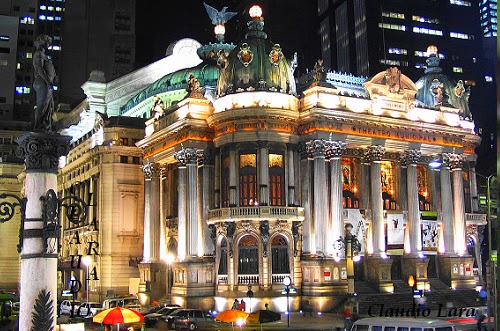FANTASTIC RIO
by Charmaine Higgins
We arrived on a balmy Sunday afternoon at Rio De Janeiro, after clearing customs and immigration, we boarded our bus to start a 4 night trip that would amaze and astound me!
The air had a sweet scented smell which I was to find out was the smell of fuel made from the Sugar cane that they used to fuel their vehicles.
We passed through the city of Rio, headed for Copacabana, 4 kilometers of fine, gold sand swept between the headlands of Leme and Arpoador, to form Copacabana,
The beach is irresistible, but Copacabana offers much more.
Here is Rio’s major concentration of hotels, from the luxurious to the simple.
Restaurants include some of the best in the city.
On Avenida Nossa Senhora de Copacabana,
and its side streets, boutiques and modern shops display chic Brazilian fashions.
Facing the beach on Avenida Atlantica,
with the world famous Copacabana Palace hotel was our destination.
Downtown Rio
 – no doubt about it, there are quieter and more peaceful
places than downtown Rio. Yet, if one really wants to experience the
very nerve of this great city, then this is the place to go. It is the
area where the once small town of Rio de Janeiro began. There it grew
to become what it is today: a densely crowded metropolis with hundreds
of tall office buildings, including a great number of sleek skyscrapers.
– no doubt about it, there are quieter and more peaceful
places than downtown Rio. Yet, if one really wants to experience the
very nerve of this great city, then this is the place to go. It is the
area where the once small town of Rio de Janeiro began. There it grew
to become what it is today: a densely crowded metropolis with hundreds
of tall office buildings, including a great number of sleek skyscrapers. It is here where hundreds of thousands of Cariocas work; mostly in air-condition offices, banks, stores and public institutions.
Avenida Rio Branco is, with the exception of Avenida Presidente Vargas, the most important main street. It practically cuts the “Centro” right through the middle. This bustling avenue with its narrow cross-streets delineates the commercial and financial heart of Rio. In the streets there is the ear-shattering noise of heavy traffic and as an alternate the ultra-modern, silent subway underground.
The downtown area is also Rio’s most important cultural center with a remarkable number of theaters, one of them being the Theatro Municipal
–
which is virtually a true copy of the Paris Opera House.
The National
Museum of Fine Arts
is a must to visit; it overlooks central Avenida
Rio Branco
and is scenically located on the shore of Guanabara Bay.
Rio’s modern Cathedral,
with stained glass windows towering 80 m above the altar, is a triumph of modern architecture. The old Imperial residence,
the Sao Bento Monastery (1641)
and the 42 arches of Lapa’s aquaduct
are just three examples of historic importance.
A visit to Corcovado was part of our itinerary.
Due to its privileged location, the impressive 710 m high Corcovado offers a fantastic, 360 degree panoramic view of the entire city.
The Corcovado sightseeing tour includes a ride on the modern Swiss cog-wheel train, which leave from its station and reaches the top after a lovely 16 minute trip through a rich and dense tropical forest. There on the peak of the mountain, the statue of Christ the Redeemer, with arms opened wide as if he were blessing the city below. It stands an impressive 38 m high with a width of 28 m and weighs 1450 tons. You really haven’t seen Rio, unless you have seen it from the Corcovado.
Then onto Sugar Loaf,
to the east, Rio’s most well known symbol, the
sold 396 m high granite rock, named ”Pão de Açucar” or Sugar Loaf
stands like a motionless sentinel, overlooking the entry of the enormous
Guanabara Bay.
Nowadays it is quite easy to reach the peak of the
mountain in a modern and comfortable cable-car.
The ascent is divided in two parts, each of which takes note more than a
few minutes. After the first ride you find yourself on the top of the
“Morro da Urca” at 230 m.
Here is the first spectacular outlook of Botafogo Bay,
the Yacht Club,
Flamengo Park,
Downtown Rio and the
mountains.
After a two minute walk you reach the next station, where you take
another cable-car. The second part of the trip takes you right up to
the top of the Sugar Loaf itself.















